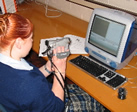Primary 7
As part of a unit of work on ‘belonging’ in Christianity and Sikhism a Year 2 class used a cluster of computers to explore similarity and difference, and the importance of symbols of belonging in two religions.
The unit provided opportunities for pupils to:
enquire into and engage with a concept that is important in their own experience and in religion (belonging)
communicate their own responses to the concept of belonging
apply the concept of belonging to their own and others’ experiences
recognise that belonging and symbols representing belonging are common to many religions
reflect on how the concept of belonging is expressed in their own lives.
Activity 1: Thinking about similarity and difference
In the first lesson of the unit pupils were presented with a photograph of the class that had been scanned in advance and dropped into a simple table to the one below:
Working in pairs, the pupils inserted text into the table in the columns either side of the picture, identifying similarities and differences between the pupils in the photograph. Some pupils benefited from having a word bank of key words. The class worked through the day, each pair taking approximately ten minutes to complete the task. They saved their ideas into a shared folder on the hard drive and printed a copy for use in class discussion later in the day.
During the final discussion pupils applied suitable criteria for sorting the similarities and differences they had recorded, for example:
physical (boys/girls, size, hair colour, clothing and so on)
emotional (friendship groups)
practical (school groups, out of school activities).
The teacher then formally introduced the idea of ‘belonging’ and asked pupils to consider the different groups to which they ‘belonged’. For example:
How might it feel to join a new group?
How might their actions affect others?
Activity 2: Symbols of belonging ‘odd one out’
Towards the end of the unit pupils looked at three objects: a school jumper, a crucifix pendant and a kirpan. Through a brief introductory discussion they identified all three as symbols of belonging to specific groups.
Photographs of the three items had been put into tables on the class computers in advance and pupils were asked to suggest which symbol of belonging was the ‘odd one out’.
Working in pairs at the computer, pupils dragged and dropped the image of the item they chose and added a brief statement explaining their choice. Their responses were printed out anonymously and displayed as a focus for a final discussion.
Examples of pupils’ comments:
The jumper is the odd one out because only pupils can belong to this group; you can be a Sikh or Christian when you are a grown up or a child.
The cross is the odd one out because you wear it round your neck; the others go on your body.
The kirpan is the odd one out because it’s the only one people don’t have at our school.
The jumper is the odd one out because it’s the only one that is proper clothes.
The kirpan is the odd one out because it’s the only one that can be dangerous.
The responses prompted further discussion in which pupils:
realised that if a child at the school was a Sikh they might have an item representing the kirpan, butthat it would not be a full sword and therefore not dangerous
challenged the stereotypes they had created and came to the conclusion that any of the items could be the odd one out.
Pupils were then asked: 'If all three items were in one group, what would the title of the group be?' All answered that in some form the items could all go into a group that showed you belonged to a special group.
The use of ICT:
supported the RE learning objective chosen for the unit (based on the agreed syllabus) more effectively than traditional resources would achieve
is appropriate to pupils working at level 2 of QCA’s non-statutory national framework for RE (2004).
By using ICT, pupils were:
encouraged to ask, and respond sensitively to, questions about their own and others’ experiences and feelings
encouraged to use appropriate words and phrases to identify features of certain religions and their importance for some people
starting to make links between objects and their symbolic meanings for individuals
provided with an opportunity to develop respect for all, and for reflection.
How ICT enhanced teaching and learning
Commenting on the use of ICT to meet the learning objectives, the teacher said that:
pupils were able to think about and express their ideas and responses at a higher level than would have been likely using traditional resources
high-quality images were readily available
collaboration was encouraged
those weaker at writing were able to make a full contribution, focusing on their responses free from concerns about layout and structure
pupils were highly motivated to engage with the activities
the activities were quick to prepare, and easy to explain and use.
Related Resources on the Becta website
Using digital images to stimulate reflective thinking - go
Using web-based resources in primary religious education - go
How to use digital video in religious education - go
Ten ways to use a digital camera in religious education - go
Using a digital projector in religious education - go

